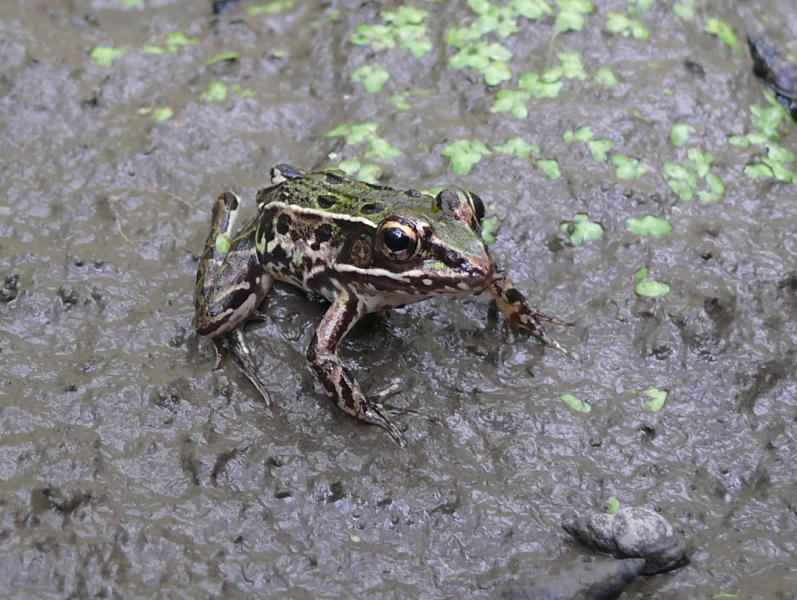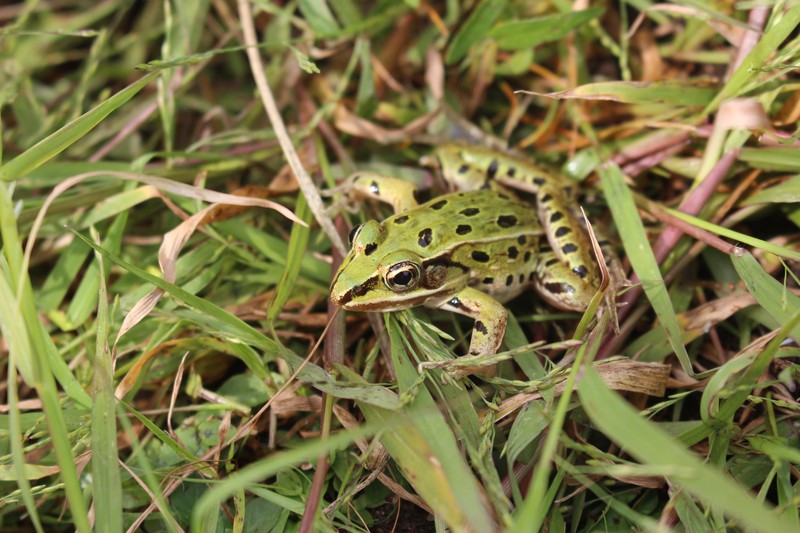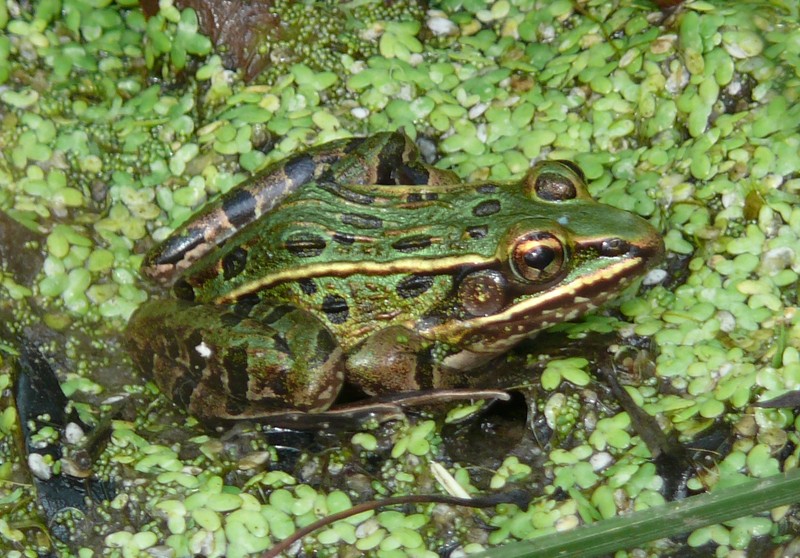Atlantic Coast Leopard Frog
Lithobates kauffeldi Feinberg, Newman, Watkins-Colwell, Schlesinger, Zarate, Curry, Shaffer, and Burger, 2014
- Class
- Amphibia (Amphibians)
- Family
- Ranidae (True Frogs)
- State Protection
- Not Listed
Not listed or protected by New York State.
- Federal Protection
- Not Listed
- State Conservation Status Rank
- S1S2
Critically Imperiled or Imperiled in New York - Especially or very vulnerable to disappearing from New York due to rarity or other factors; typically 20 or fewer populations or locations in New York, very few individuals, very restricted range, few remaining acres (or miles of stream), and/or steep declines. More information is needed to assign either S1 or S2.
- Global Conservation Status Rank
- G3G4
Vulnerable globally, or Apparently Secure - At moderate risk of extinction, with relatively few populations or locations in the world, few individuals, and/or restricted range; or uncommon but not rare globally; may be rare in some parts of its range; possibly some cause for long-term concern due to declines or other factors. More information is needed to assign either G3 or G4.
Summary
Did you know?
The Atlantic Coast Leopard Frog is only one of two newly described frog species from the United States in the last 30 years.
State Ranking Justification
The Atlantic Coast leopard frog appears to have declined precipitously in New York, including vanishing from Long Island. A handful of populations remain in the lower Hudson Valley and on Staten Island.
Short-term Trends
Short-term trends are unknown. Despite considerable survey effort, leopard frogs have not been confirmed on Long Island since the mid-1990s, so major declines in that region are likely.
Long-term Trends
Over the long term, this species has been in precipitous decline in the state, having disappeared from much of New York City and the Hudson Valley and all of Long Island.
Conservation and Management
Threats
Loss and fragmentation of wetlands, the expansion of bullfrogs, and invasion of wetlands by the common reed Phragmites are potential threats. Studies specific to the Atlantic Coast leopard frog are needed, including studies to determine genetic connectivity among populations to ensure that the isolated nature of some populations has not led to inbreeding depression. Fragmentation has additional, more immediate direct effects on mobile individuals in the form of road mortality. Highways and other major roads bisect leopard frog habitat throughout the Northeast, and frogs are often killed when crossing them. In fact, many of our samples were obtained from road-killed frogs. High-volume or multi-lane roads may serve as permanent, impenetrable barriers to dispersal, which, along with road mortality, can have considerable impacts on anuran abundance.
Another point of concern for the Atlantic Coast leopard frog is the coastal proximity of many populations. Coastal populations of wetland organisms may be threatened by rising sea levels and increasing frequency and intensity of coastal storms, both of which may increase with climate change. Storms may cause saltwater overwash into freshwater habitats, and ongoing research (Feinberg et al., unpubl. data) is addressing the tolerance of Atlantic Coast leopard frogs to brackish conditions and persistence in coastal sites after major storm events. In Delaware, large calling choruses disappeared from freshwater impoundments along the Delaware Bay following storms that altered the coastline creating inlets that allowed for inflow of saltwater (J. White, pers. comm.). More inland (typically large-river riparian) populations may be less vulnerable to these changing coastal conditions, but also possibly less adapted to storm-related flooding.
Apart from the pine barrens treefrog (Hyla andersoni) and New Jersey chorus frog (Pseudacris kalmi), no eastern US anuran north of Florida has as small a range as the Atlantic Coast leopard frog A small range may make a species more susceptible to stochastic events, and for frogs, may exacerbate the impact of fungal pathogens like Batrachochytrium dendrobatidis (Bd). Bd has recently been documented in the Atlantic Coast leopard frog (J. Feinberg, unpublished data) as it has in the northern and southern leopard frogs and many other ranids.
Conservation Strategies and Management Practices
For species such as leopard frogs that spend considerable time in the uplands, the landscape surrounding the aquatic breeding habitat may also be crucial to long-term persistence. Based on typical migration distances reported in the literature on other amphibian species, a terrestrial buffer around breeding habitat of several hundred meters is likely necessary to ensure suitable upland habitat, although in at least one highly urban setting the species appears to survive with little surrounding upland greenspace.
Research Needs
As with any newly described species, there is still much to learn about R. kauffeldi’s ecology and natural history. Descriptions of R. kauffeldi egg masses and tadpoles are lacking, and the ability to distinguish species based especially on tadpoles would be a boon to detailed natural history, ecological, and demographic studies. For example, adaptations of the various life stages to particular environmental conditions and stressors may help explain the geographic and ecological distributions of the species. Given the highly urban setting of many populations, the susceptibility to environmental contaminants of the various life stages, and potential impacts of noise on anuran communication, are of great interest. Research into possible competitive interactions may shed light on any niche separation given the overlap with R. sphenocephala and R. pipiens and the suggestion of hybridization in both the genetic and morphological data, and help explain observed declines.
Habitat
Habitat
In New York, leopard frogs occur primarily in open habitats, including grasslands, wet meadows, grassy edges, shallow wetlands, and clear, slow-moving ditches. They are rarely found fall from water although in summer they may use grassy areas adjacent to breeding habitat.
Associated Ecological Communities
- Brackish meadow*
(guide)
A moist, moderately well-drained brackish (salinity 0.5-18 ppt) perennial grassland with occasional isolated shrubs that is typically situated in a belt at the upper edge of salt marshes bordering sandy uplands, but may occupy large portions of interdunal basins. The community usually develops in areas with a unique combination of soils and hydrology, on deep deposits of periodically windblown or overwashed gleyed sands that are usually flooded only during spring tides and during major coastal storms, approximately two to three times per year.
- Brackish tidal marsh*
(guide)
A marsh community that occurs where water salinity ranges from 0.5 to 18.0 ppt, and water is less than 2 m (6 ft) deep at high tide. The vegetation in a brackish tidal marsh is dense and dominated by tall grass-like plants.
- Deep emergent marsh
(guide)
A marsh community flooded by waters that are not subject to violent wave action. Water depths can range from 6 in to 6.6 ft (15 cm to 2 m). Water levels may fluctuate seasonally, but the substrate is rarely dry, and there is usually standing water in the fall.
- Floodplain forest*
(guide)
A hardwood forest that occurs on mineral soils on low terraces of river floodplains and river deltas. These sites are characterized by their flood regime; low areas are annually flooded in spring, and high areas are flooded irregularly.
- Floodplain grassland*
(guide)
A somewhat densely vegetated, tall grassland community that occurs on the floodplains along the upper reaches of larger confined rivers. This community occurs on relatively stable sand/gravel or cobble substrate that is often visible between the clump forming grasses. These floodplain shores and islands are typically broad and the soil is coarse and dry. These grasslands are subject to flooding and ice scour, but ice floes usually do not persist into spring as in riverside ice meadows.
- Freshwater tidal marsh*
(guide)
A marsh community that occurs in shallow bays, shoals, and at the mouth of tributaries of large tidal river systems, where the water is usually fresh (salinity less than 0.5 ppt), and less than 2 m (6 ft) deep at high tide. Typically there are two zones in a freshwater tidal marsh: a low-elevation area dominated by short, broadleaf emergents bordering mudflats or open water, and a slightly higher-elevation area dominated by tall grass-like plants.
- Freshwater tidal swamp*
(guide)
A forested or shrub-dominated tidal wetland that occurs in lowlands along large river systems characterized by gentle slope gradients coupled with tidal influence over considerable distances. The swamp substrate is always wet and is subject to semidiurnal flooding by fresh tidal water (salinity less than 0.5 ppt).
- Red maple-hardwood swamp
(guide)
A hardwood swamp that occurs in poorly drained depressions, usually on inorganic soils. Red maple is usually the most abundant canopy tree, but it can also be codominant with white, green, or black ash; white or slippery elm; yellow birch; and swamp white oak.
- Shallow emergent marsh
(guide)
A marsh meadow community that occurs on soils that are permanently saturated and seasonally flooded. This marsh is better drained than a deep emergent marsh; water depths may range from 6 in to 3.3 ft (15 cm to 1 m) during flood stages, but the water level usually drops by mid to late summer and the soil is exposed during an average year.
* probable association but not confirmed.
Range
New York State Distribution
The Atlantic Coast leopard frog is known definitively from four locations on Staten Island, three in Orange County, and one in Putnam County. Historically, it occupied much of New York City and Long Island as well as many more locations in the lower Hudson Valley.
Global Distribution
This species' global range has not been fully assessed but it appears to occupy a narrow stretch of the Atlantic coastal plain extending from northern North Carolina northward, up large river valleys in New York and Connecticut.
Identification Comments
General Description
Leopard frogs are green or brown, usually with irregularly spaced rounded dark spots on the back and a few dark spots on the sides of the body. A continuous usually yellowish ridge extends along each side of the back. The head is pointed, and sometimes there is a light spot in the center of the eardrum. The hind toes are extensively webbed. Maximum size is around 5.1 inches (13 cm) snout-vent length. Breeding males have vocal sacs at the angles of the jaw; the sacs are spherical when inflated. The forelimbs of mature males are more massive than those of females, and the base of the thumb is larger in males than in females. The breeding call is a repeated single chuck combined with an occasional drawn-out snore. Larvae have faint to dark mottling on the body and tail, and the eyes are positioned on top of head, not at the margin of the head, when viewed from above. Maximum size of larvae is about 3 inches (7.6 cm) in total length. Egg masses are baseball sized when the jelly is fully expanded and contain roughly 1,000-1,500 eggs.
Identifying Characteristics
A brown to green frog with rounded spots, distinct dorsolateral lines, and an occasional white spot on the tympanum. The reticulum (upper thighs) is typically dark with light spots. The call is a single-pulsed "chuck" with an occasional rolling "snore."
Characters Most Useful for Identification
A dark femoral reticulum (upper thigh area), occasional tympanum spots, snout shape, and overall coloration reliably separates this species from the Southern Leopard Frog 90% of the time (Schlesinger et al. 2018). But the primary mating call described by Feinberg et al. (2014) remains the only truly diagnostic feature in the field.
Best Life Stage for Proper Identification
As the tadpole and egg mass have yet to be described, the adult stage is the only stage in which this frog can be distinguished visually from similar species. The call of the adult is diagnostic.
Behavior
Leopard frogs are primarily nocturnal. Males typically call between midnight and daybreak. They are very skittish and can make quick leaps into vegetation or water when they feel threatened. Egg masses of 3,000 to 5,000 eggs are often laid communally. Tadpoles hatch in 7-12 days and transform into adults in 2-3 months. Late-hatching eggs may overwinter as tadpoles. The frogs migrate between breeding pools and upland foraging areas. They hibernate in mucky bottoms of wetlands. (Gibbs et al. 2007)
Diet
Tapoles feed on algae, plant material, and organic debris while adult frogs feed on small invertebrates such as beetles, caterpillars, and spiders (Gibbs et al. 2007, Natureserve 2007).
- Present
- Active
- Reproducing
The time of year you would expect to find Atlantic Coast Leopard Frog present, active, and reproducing in New York.
Similar Species
- Pickerel Frog (Lithobates palustris)
The pickerel frog has a yellow/tan wash on the underside of the legs and squarish as opposed to rounded spots. It may be cream or tan colored, which leopard frogs rarely are. Juvenile pickerels may be hardest to distinguish from leopards as their spots may look round and the leg color is less prominent.
- Northern Leopard Frog (Lithobates pipiens)
Northern leopard frogs never have a white spot on the tympanum, but rarely have a darker splotch. Their reticulums (upper thighs) are rarely dark with light spots.
- Southern Leopard Frog (Lithobates sphenocephalus)
Southern leopards have a more pointed snout and a more defined white spot on the tympanum, and usually have a light reticulum with dark spotting. These two species may not yet be reliably distinguishable in the field, except by call. Southern leopards have a rolling series of "chucks," as opposed to individual "chucks" by the Atlantic Coast leopard.
- Wood Frog (Lithobates sylvaticus)
These two are unmistakable visually, but the wood frog's call sounds much like the Atlantic Coast leopard's. However, the "chuck" sounds of the wood frog are multi-parted (three sounds quickly in succession) and there are no "snores."
Atlantic Coast Leopard Frog Images
Taxonomy
Atlantic Coast Leopard Frog
Lithobates kauffeldi Feinberg, Newman, Watkins-Colwell, Schlesinger, Zarate, Curry, Shaffer, and Burger, 2014
- Kingdom Animalia
- Phylum Craniata
- Class Amphibia
(Amphibians)
- Order Anura
(Frogs and Toads)
- Family Ranidae (True Frogs)
- Order Anura
(Frogs and Toads)
- Class Amphibia
(Amphibians)
- Phylum Craniata
Comments on the Classification
Newman et al. (2012) presented evidence that Lithobates kauffeldi is genetically distinct from both Lithobates sphenocephalus and Lithobates pipiens. In 2014 Feinberg et al. named it as Rana (= Lithobates) kauffeldi.
Additional Resources
References
Feinberg, J. A., C. E. Newman, G. J. Watkins-Colwell, M. D. Schlesinger, B. Zarate, B. R. Curry, H. B. Shaffer, and J. Burger. 2014. Cryptic diversity in Metropolis: Confirmation of a new leopard frog species (Anura: Ranidae) from New York City and surrounding Atlantic Coast regions. PloS one 9:e108213.
New York Natural Heritage Program. 2024. New York Natural Heritage Program Databases. Albany, NY.
Newman, C. E., J. A. Feinberg, L. J. Rissler, J. Burger, and H. B. Shaffer. 2012. A new species of leopard frog (Anura: Ranidae) from the urban northeastern US. Molecular Phylogenetics and Evolution 63:445-455.
Schlesinger, M. D., J. A. Feinberg, N. H. Nazdrowicz, J. D. Kleopfer, J. C. Beane, J. F. Bunnell, J. Burger, E. Corey, K. Gipe, J. W. Jaycox, E. Kiviat, J. Kubel, D. P. Quinn, C. Raithel, P. A. Scott, S. M. Wenner, E. L. White, B. Zarate, and H. B. Shaffer. 2018. Follow-up ecological studies for cryptic species discoveries: Decrypting the leopard frogs of the eastern U.S. PLOS ONE 13:e0205805.
About This Guide
This guide was authored by: Matthew D. Schlesinger
Information for this guide was last updated on: July 29, 2021
Please cite this page as:
New York Natural Heritage Program. 2024.
Online Conservation Guide for
Lithobates kauffeldi.
Available from: https://guides.nynhp.org/atlantic-coast-leopard-frog/.
Accessed July 27, 2024.


